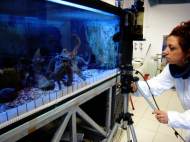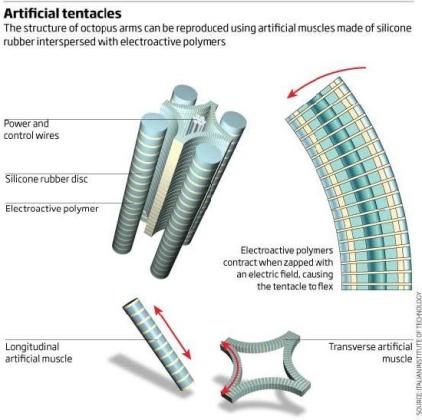Robot octopus shows great potential as an addition to mini subs
 Cecilia Laschi, of Scuola Superiore Sant’Anna in Pisa, and her colleagues are attempting to build a robot with arms that work in the same way that octopuses’ tentacles do. Having no solid skeleton, it will be the world’s first entirely soft robot. Their goal is to use the knowledge related to the principles that give rise to the octopus sensory-motor capabilities and incorporate them in new design approaches in robotics. It is mainly based on the anatomy of the 8-arm body of an octopus, with similar performance in water, in terms of dexterity, speed, control, flexibility, and applicability.
Cecilia Laschi, of Scuola Superiore Sant’Anna in Pisa, and her colleagues are attempting to build a robot with arms that work in the same way that octopuses’ tentacles do. Having no solid skeleton, it will be the world’s first entirely soft robot. Their goal is to use the knowledge related to the principles that give rise to the octopus sensory-motor capabilities and incorporate them in new design approaches in robotics. It is mainly based on the anatomy of the 8-arm body of an octopus, with similar performance in water, in terms of dexterity, speed, control, flexibility, and applicability.
The trouble with today’s remote-controlled subs is that their large hulls and clunky robot arms cannot reach into the nooks and crannies of coral reefs or the rock formations on ocean floors. That means they are unable to photograph objects in these places or pick up samples for analysis. And that’s a major drawback for oceanographers hunting for signs of climate change in the oceans and on coral reefs. The OCTOPUS project shows the potential to become a common addition to remote-controlled subs.
One of the special abilities octopuses have is that their body has no rigid structure. Thanks to that ability, the octopus can adapt its shape to the environment and its whole body can be squeezed into very small aperture. The octopus has the capability to twist, elongate, and bend its arms in all directions and, despite of the lack of rigid skeletal support, can vary the stiffness of its tentacles in order to apply relatively high forces. The control of this large number of degrees of freedom is highly distributed and is simplified by the use of stereotyped movements. The tentacles are effectively used to move on the diverse substrates of the sea bottom and to reach, grasp and even manipulate objects with extraordinary dexterity.
“So we are replicating the muscular structure of an octopus by making a robot with no rigid structure – and that is completely new to robotics,” she says, ”We are making a robot with no rigid structure. And that is completely new to robotics.”
The octopus has evolved interesting and maneuverable muscle architecture. Each tentacle has four independent muscles running along its length. These longitudinal muscles are separated by transverse muscles which span the width of the limb with an axial controlling nerve that passes through its centre. This arrangement keeps the tentacle’s volume constant, so when it extends a limb by elongating the longitudinal muscles and contracting the transverse ones, it also becomes narrower.
Laschi and her colleagues in the UK, Switzerland, Turkey, Greece and Israel are testing artificial muscle technologies that will more accurately mimic tentacles (Biomimetics and Bioinspiration). The team plans to mimic the longitudinal muscles with soft silicone rubber interspersed with a type of electroactive polymer (EAP) called a dielectric elastomer. When you apply an electric field to that material and it squeezes the silicone, making it shorter.
OCTOPUS can be considered as a basic (scientific and technological) research project with an impact both in engineering and biology fields. New science and new scientific data will result from the focused research on the octopus, as well as from some of the experimental activities during the technological development phases. New technology and new design principles will come out in the form of prototypes, both for components and for an integrated system. The results expected from OCTOPUS will have an impact on academic researchers in engineering and biology and on the future development of ICT and robotics.










Is there a working prototype and if so if there proof release on some platform.
Hi Anthony, sorry for my late reply.
There have been news and exibits of this project with last updates around 2013. You can see events and spin out projects at this link of Octopus Project results.